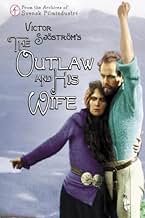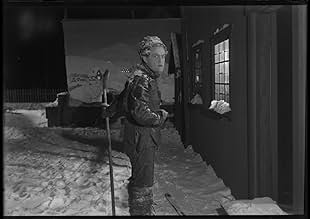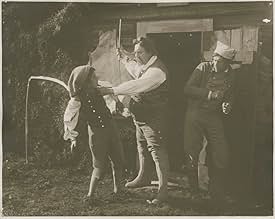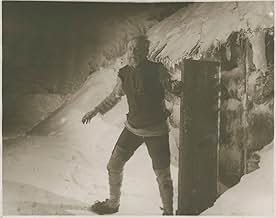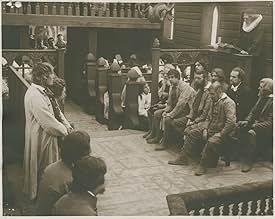NOTE IMDb
7,1/10
2,2 k
MA NOTE
Ajouter une intrigue dans votre langueEjvind and his family are in need of food. So Ejvind seeks help from the rich priest next door. He refuses to help. Ejvind then steals a sheep from the priest, he is caught. But he escapes f... Tout lireEjvind and his family are in need of food. So Ejvind seeks help from the rich priest next door. He refuses to help. Ejvind then steals a sheep from the priest, he is caught. But he escapes from prison, and becomes an outlaw.Ejvind and his family are in need of food. So Ejvind seeks help from the rich priest next door. He refuses to help. Ejvind then steals a sheep from the priest, he is caught. But he escapes from prison, and becomes an outlaw.
- Réalisation
- Scénario
- Casting principal
Walerie Alexandrow-Höök
- Berg-Ejvinds och Hallas dotter Tota
- (as Walerie Alexandrow)
Avis à la une
(1918) The Outlaw and His Wife/ Berg-Ejvind och hans hustru
SILENT DRAMA
Co-written, directed and starring Victor Sjöström, he plays an unknown drifter, Kari (Victor Sjöström) looking for work and ends up working at a farm, owned by Halla (Edith Erastoff). And as they begin to fall in love, it is then his past begins to catch up with him that his name is not Kari, but is really Eyvind suspected of escaping from prison. Adapted from the play "Eyvind of the Hills" by Jóhann Sigurjónsson.
A silent Swedish film that is reminiscent of a serious love story that has a complicated situation, that can be used as a basis for movies that come after it.
Co-written, directed and starring Victor Sjöström, he plays an unknown drifter, Kari (Victor Sjöström) looking for work and ends up working at a farm, owned by Halla (Edith Erastoff). And as they begin to fall in love, it is then his past begins to catch up with him that his name is not Kari, but is really Eyvind suspected of escaping from prison. Adapted from the play "Eyvind of the Hills" by Jóhann Sigurjónsson.
A silent Swedish film that is reminiscent of a serious love story that has a complicated situation, that can be used as a basis for movies that come after it.
7Foxx
This film was Victor Sjöströms international break-through and it's not hard to understand why. It wasn't the first time Sjöström had used the wild and unpredictable nature as an illustrator or commentator, but this time the scenery and the acting was in the same level of quality. A wonderful piece of art.
On my continued journey through silent film from the early 20th century, this is my favorrite one yet. I found the changing colors much less distracting, and at points even felt like the colors added to the tone of the scene. I particularly enjoyed the costumes in this film, and found the plot much easier to follow than other films of this category. I enjoyed seeing a strong female character, unlike in 'A Man There Was'. There are both laughs and cries throughout this film, and the ending I thought was beautiful. The title cards consisted of more dialogue than I'd seen in previous films, which helped to make the plot more understandable.
The Outlaw and His Wife (1918) directed by Victor Sjöström is yet another impressive production in early cinema history.
The story revolves around a stranger who comes to work at a widow's (Halla's) farm. Halla and the stranger fall in love, but when he is revealed as Eyvind, an escaped thief forced into crime by his family's starvation, they flee and become two of the many outlaws of Iceland's mountains.
Victor Sjöström's early films are impressive in their own right. In The Outlaw and his Wife, he almost uses nature as a character, pressuring the humans of the film to the very brink of - and beyond - their moral values. This works effectively in driving a more abstract point of the film; what is one willing to do in order to ensure one's own safety and survival, and yet further abstract; what is good and evil as philosophical constructs?
It is similarly highly recommended for film buffs and those interested in cinema history just like Sjöström's earlier film Terje Vigen (1917), although The Outlaw and his Wife is not as contemporary as Terje Vigen. Lacking a score and being twice as long, it does not feel as focused although it definitely is more epic in its scale and production.
The story revolves around a stranger who comes to work at a widow's (Halla's) farm. Halla and the stranger fall in love, but when he is revealed as Eyvind, an escaped thief forced into crime by his family's starvation, they flee and become two of the many outlaws of Iceland's mountains.
Victor Sjöström's early films are impressive in their own right. In The Outlaw and his Wife, he almost uses nature as a character, pressuring the humans of the film to the very brink of - and beyond - their moral values. This works effectively in driving a more abstract point of the film; what is one willing to do in order to ensure one's own safety and survival, and yet further abstract; what is good and evil as philosophical constructs?
It is similarly highly recommended for film buffs and those interested in cinema history just like Sjöström's earlier film Terje Vigen (1917), although The Outlaw and his Wife is not as contemporary as Terje Vigen. Lacking a score and being twice as long, it does not feel as focused although it definitely is more epic in its scale and production.
It is a truism that Victor Sjostrom's films dramatise the conflict between nature and society, but his treatment is less simplistic than might be first apparent. For instance, society in 'The Outlaw and his Wife' is ruled by a brutal, land-grabbing Bailiff who whips servants for losing a sheep; but it is also a place rich in pageantry, costume and rite, where communities can express themselves.
Similarly, nature might be a site of freedom for social outsiders, a sustaining idyll for lovers, and an awe-inspiring backdrop, but it also overflows in the lonely vagrant who comes close to rape, or the cliff and snows that can kill.
Throughout Sjostrom shifts impressively between registers - nature as both real presence and symbolic backdrop; plot as both social depiction and spiritual journey - while retaining familiar action pleasures.
Similarly, nature might be a site of freedom for social outsiders, a sustaining idyll for lovers, and an awe-inspiring backdrop, but it also overflows in the lonely vagrant who comes close to rape, or the cliff and snows that can kill.
Throughout Sjostrom shifts impressively between registers - nature as both real presence and symbolic backdrop; plot as both social depiction and spiritual journey - while retaining familiar action pleasures.
Le saviez-vous
- AnecdotesBased on the story of Eyvindur of the Mountains (1714-1783), an outlaw in Iceland who fled into the mountains with his wife around 1760 and remained there for twenty years.
- Versions alternativesTurner Classic Movies has shown on TV a restored version copyrighted in 1968 by Svenska Filminstitutet (The Swedish Film Instute). The restoration credits are in Swedish, but some of the original cast and crew credits are in English. All intertitles are in English and the film runs 73 minutes.
- ConnexionsFeatured in Victor Sjöström - ett porträtt av Gösta Werner (1981)
- Bandes originalesKung Kristian II, op. 27
Composed by Jean Sibelius (1898)
Meilleurs choix
Connectez-vous pour évaluer et suivre la liste de favoris afin de recevoir des recommandations personnalisées
- How long is Berg-Ejvind och hans hustru?Alimenté par Alexa
Détails
- Date de sortie
- Pays d’origine
- Site officiel
- Langue
- Aussi connu sous le nom de
- The Outlaw and His Wife
- Lieux de tournage
- Nuolja, Abisko, Suède(mountain scenery)
- Société de production
- Voir plus de crédits d'entreprise sur IMDbPro
Box-office
- Budget
- 100 000 SEK (estimé)
- Durée
- 1h 12min(72 min)
- Mixage
- Rapport de forme
- 1.33 : 1
Contribuer à cette page
Suggérer une modification ou ajouter du contenu manquant

